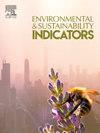气候变化下水资源和环境承载能力评估的新框架:Zarrinehrud盆地经验
IF 5.6
Q1 ENVIRONMENTAL SCIENCES
引用次数: 0
摘要
本文提出了一种利用驱动因素-压力-状态-影响-响应(DPSIR)框架量化和评估水资源和环境承载能力(wreck)的新方法。与以往的方法不同,我们的框架通过“影响”部分明确地将影响途径整合到“破坏破坏”估算中,捕捉上游变化(例如,驱动因素和压力)对可持续性结果的长期系统性影响。有针对性的策略旨在通过直接和/或间接修改DPSIR标准来提高气候变化情景下(代表性浓度路径(RCP) 4.5、6.0和8.5)的WRECC,并对环境、社会经济和文化维度的影响进行评估。利用考虑利益相关者效用的退步议价方法选择优策略,以确保可行性和可接受性。应用于伊朗的Zarrinehrud盆地,该盆地位于世界第二大咸水湖Urmia湖盆地内,该框架显示,由于农业扩张和气候压力,基线条件下的WRECC严重超载。采用气候变化情景(即RCP 4.5、RCP 6.0和RCP 8.5)对2000-2023年和2024-2039年40种策略进行的模拟表明,仅采用常规措施(如灌溉效率)无法恢复平衡。相比之下,S39战略在促进工业和旅游业的同时,减少了30%的农业就业,从而使农村资源平衡提高了53%,到2039年达到平衡状态。主要研究结果强调,针对“驱动因素”(例如,就业转移)的战略优于那些只关注“压力”或“国家”因素的战略,这强调了系统性干预的必要性。该框架的适应性为面临类似可持续性挑战的流域提供了可转移的工具。本文章由计算机程序翻译,如有差异,请以英文原文为准。

A novel framework for evaluating water resources and environmental carrying capacity under climate change: The Zarrinehrud Basin experience
This paper presents a novel approach for quantifying and assessing water resources and environmental carrying capacity (WRECC) leveraging the Drivers-Pressures-State-Impacts-Responses (DPSIR) framework. Unlike previous approaches that were based on aggregating all DPSIR indicators to quantify WRECC, our framework explicitly integrates influence pathways into WRECC estimation through the “Impacts” component, capturing long-term systemic effects of upstream changes (e.g., drivers and pressures) on sustainability outcomes. Targeted strategies are designed to enhance WRECC under climate change scenarios (representative concentration pathway (RCP) 4.5, 6.0, and 8.5) by directly and/or indirectly modifying DPSIR criteria, with impacts evaluated across environmental, socio-economic, and cultural dimensions. The superior strategy is selected using the fallback bargaining method incorporating stakeholder utilities to ensure feasibility and acceptance. Applied to Iran's Zarrinehrud Basin, located within the Lake Urmia basin, the world's second largest saltwater lake, the framework reveals baseline conditions' WRECC as severely overloaded due to agricultural expansion and climate pressures. Simulations of 40 strategies for the periods 2000–2023 and 2024–2039, using climate change scenarios (i.e., RCP 4.5, RCP 6.0, and RCP 8.5) demonstrate that conventional measures (e.g., irrigation efficiency) alone fail to restore balance. In contrast, Strategy S39, reducing agricultural employment by 30 % while promoting industry and tourism, improves WRECC by 53 %, achieving a balanced state by 2039. Key findings highlight that strategies targeting “drivers” (e.g., employment shifts) outperform those focused solely on “pressures” or “state” components, underscoring the need for systemic interventions. The proposed framework's adaptability offers a transferable tool for basins facing similar sustainability challenges.
求助全文
通过发布文献求助,成功后即可免费获取论文全文。
去求助
来源期刊

Environmental and Sustainability Indicators
Environmental Science-Environmental Science (miscellaneous)
CiteScore
7.80
自引率
2.30%
发文量
49
审稿时长
57 days
 求助内容:
求助内容: 应助结果提醒方式:
应助结果提醒方式:


